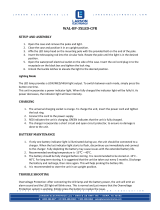
Form 6 NX-T/LS microprocessor-based pole-mount recloser control
10 INSTALLATION AND OPERATION INSTRUCTIONS MN280089EN July 2018
GND TRIP BLOCKED
The Ground Trip Blocked function blocks all ground sensing
in the control for the active profile. This red indicator is
illuminated when Ground Trip Block is activated from the
serial port, I/O, the interface software, or locally causing the
control to block all ground sensing.
NON RECLOSING
The Non-reclosing mode disables any automatic reclosing
operations. The red indicator is illuminated when the control
is operating in a non-reclosing mode. Non-reclosing does
not alter the active TCC. Activation is possible from the
SCADA port, I/O, the interface software, or locally (via the
front panel).
SUPERVISORY OFF
When the SUPERVISORY OFF red indicator is illuminated,
supervisory commands are blocked. Supervisory functions
through the back panel serial communication ports and the
discrete I/O are blocked. Serial communications through
the front panel RS-232 port remain active independent of
the status of the SUPERVISORY OFF switch. Activation
of this function key is restricted to the operator panel and
is accomplished by pressing the CHANGE key and then
pressing the SUPERVISORY OFF key. Operational data
and metering information are available while the control is
in the SUPERVISORY OFF position. The TRIP and CLOSE
pushbuttons and Hot Line Tag are active independent of the
SUPERVISORY OFF function.
A PHASE SELECT, B PHASE SELECT, C PHASE SELECT
The Form 6 NX-T/LS control when in Single-Phase Trip/
Single-Phase Lockout mode has phase selection keys
available for the user to indicate only which phase of the
triple-single recloser will operate when the manual TRIP
(LOCKOUT) and CLOSE pushbuttons on the Form 6 NX-T/
LS operator panel are pressed. When the TRIP or CLOSE
buttons are pressed, only the phases that are selected (LED
on) will trip or close.
Manual operation of the yellow handles on the triple-single
recloser is used to open and lockout the phases, and to
disable the electrical and supervisory closing. The recloser
mode of operation determines which phases open and
close. The Form 6 NX-T/LS control initiates the close signal.
WARNING
Hazardous voltage. Do not rely on the open position of
the yellow operating handle; it does not ensure that the
line has been de-energized. Always establish a visible
disconnect. Failure to follow proper safety practices can
result in contact with high voltage, which will cause
death or severe personal injury. G116.0
IMPORTANT
Pushing the yellow operating handle to the CLOSE position
will not close the recloser. All close operations are initiated
by the Form 6 NX-T/LS control.
Three-Phase Trip – Three-Phase Lockout (ganged)
or
Single-Phase Trip – Three-Phase Lockout
If the control is in Three-Phase Trip – Three-Phase Lockout
(ganged) mode or Single-Phase Trip – Three-Phase Lockout
mode, all three phases are permanently selected and the A
PHASE SELECT, B PHASE SELECT, and C PHASE SELECT
LEDs are illuminated.
When one phase is opened with the yellow operating
handle, all three phases open and lockout. The RECLOSER
OPEN and CONTROL LOCKOUT indicator LEDs illuminate
on the control panel.
With the yellow operating handle of the appropriate phase
in the CLOSE position, press the CLOSE pushbutton on
the control operator panel. All three phases close and the
RECLOSER CLOSED LED illuminates.
Single-Phase Trip – Single-Phase Lockout
When in Single-Phase Trip – Single-Phase Lockout mode any
combination of phases can be selected and the respective
PHASE SELECT LED illuminates. Each selected phase must
be closed individually.
When the selected phase is opened with the yellow
operating handle, only that phase opens and locks out. The
RECLOSER OPEN, RECLOSER CLOSED, and CONTROL
LOCKOUT indicator LEDs blink on the control panel.
The default text message on the LCD displays the mode of
the triple-single configuration and the status of each phase.
With the yellow operating handle of the selected phase
in the CLOSE position, press the CLOSE pushbutton on
the control panel. The phase closes and the RECLOSER
CLOSED LED illuminates.
IMPORTANT
If the power save feature is enabled (default), and more than
ten minutes elapses since the last panel operation, all the
LEDs, except HOT LINE TAG (if active), will turnoff.
Verify the phase or phases you want activated are selected
prior to pressing the TRIP or CLOSE button.
With Hot Line Tag enabled in the single-phase trip/single-
phase lockout mode and the overcurrent element times
out, only the faulted phase(s) will open and the non-faulted
phase(s) will remain closed. Hot Line Tag will only prevent a
reclose/close of the opened phase(s).
LS RESET
When the LS RESET red indicator is illuminated, the LS
function has been reset and the control is ready to respond
to the next loss of voltage occurrence. Activation is possible
from the SCADA port, I/O or locally (via the front panel). This
LED cannot be de-selected. It will only turn off when an LS
action occurs.




















